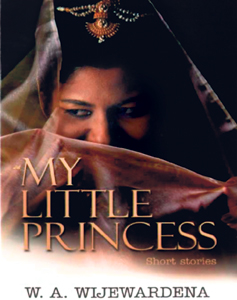
A banker traverses the path of social realities in intriguing waysMy Little Princess by W.A. Wijewardena. Sarasavi Publishers (2007). Reviewed by Nimal Sanderatne My Little Princess is an unexpected arrival on the literary scene. It is a collection of six varied pieces of short fiction that are imaginative, intriguing and enthralling. The stories grip the reader’s attention as their plots unfold in unpredictable ways. Five of the stories deal with situations and social relations that the reader may be familiar with. The other story, The Princess and the Poet, is an unusual narrative that transports us out of our own world into a realm of fairy tales with its imaginative plot and setting.
The book is surprisingly by a writer better known as an authority on economics. He is none other than W.A. Wijewardena, whose expositions on economics would be familiar to many readers. How the Deputy Governor of the Central Bank finds time to release himself from the harsh realities of monetary management into the world of fiction will remain an untold tale. The entrée of the reputed Central Banker W. A. Wijewardena into fiction reminds me of a story about T.S. Eliot who worked at the Foreign Department of Lloyds Bank in London. He worked in the bank for over eight years and his most famous work, The Waste Land, arguably the most influential poem of the twentieth century, was written during his tenure as a bank clerk. It is said that one day Ezra Pound and Wyndham Lewis, paid a visit to Lloyds Bank to meet their friend T.S. Eliot. While waiting for Eliot they got into conversation with the manager of the bank, who inquired whether there was any truth in the rumour that Eliot wrote poetry. On hearing that it was true, the manager had remarked that it was good for a man to have a hobby, as long as it did not interfere with the bank's work. I doubt that the work at Central Bank has suffered as a result of Mr. Wijewardena’s hobby, but his intent to write a novel, “depending on my time availability”, may be curtailed by his onerous duties. But the fact that in this book he has been able to write some long short stories, some of which are novellas, in a few months, lends hope that his first novel may be out quite soon. The Princess and the Poet, the longest story in the collection, is a fascinating and ingenious tale of a princess who falls in love with the court poet, whose voice and poetry fascinates her. It is a charming tale of forbidden love between two persons of different social strata in the castle. This story of “lovers”, who have never seen each other, is an imaginative tale of love defined in its purest platonic form, in contrast to the vulgar carnal desires of the man to whom the princess is given in marriage. Her cold and frigid response to the forceful advances of her husband to extract sexual pleasures in a demanding manner leads to a sequence of events that reveals her secret love and tragic end. In contrast to this story, the others in the volume relate to contemporary social situations. My Little Princess, the first story in the collection revolves around a university teacher’s close association with a student. The lecturer’s “platonic” love leads to situations of close friendship that create suspicions in the college community and result in a complex predicament, with an ending that is left to the reader’s imagination. Four Parallel Lines is the most complex and sophisticated story in the book. It is a poignant story of first love in a village where the lovers are trapped by their social class differences. A broken love affair leaves the girl sexually frigid and leads to political involvements that end in sadness. The unfolding story grips readers’ unwavering interest till its very end. The story is a serious commentary on several aspects of social life. The author’s empathy with the main character’s psychological impact of first love is particularly insightful. Similarly, Mr. Wijewardena’s story The Bachelor and the Married Man juxtaposes the life of an uninitiated young bachelor with the life of an unhappily married couple. In due course the bachelor gets involved with the married woman and he has his first sexual experience with her that eventually complicates his life. Most of the stories have social relevance, if not social depth, and impliedly a commentary on social values. They portray situations not unfamiliar to the Sri Lankan reader and yet the plots unravel in ways that are unexpected and intriguing. The author has the ability to empathise with his characters and involve the reader in the emotions of the players. He is bold, forthright, uninhibited and explicit in his descriptions of the sexual dimensions of the stories. They capture the unflagging interest of the reader whose response to the stories may reflect their own sense of values. The collection would have benefited much by some good editing and proofreading. |
|| Front
Page | News | Editorial | Columns | Sports | Plus | Financial
Times | International | Mirror | TV
Times | Funday
Times || |
| |
Reproduction of articles permitted when used without any alterations to contents and the source. |
© Copyright
2008 | Wijeya
Newspapers Ltd.Colombo. Sri Lanka. All Rights Reserved. |
